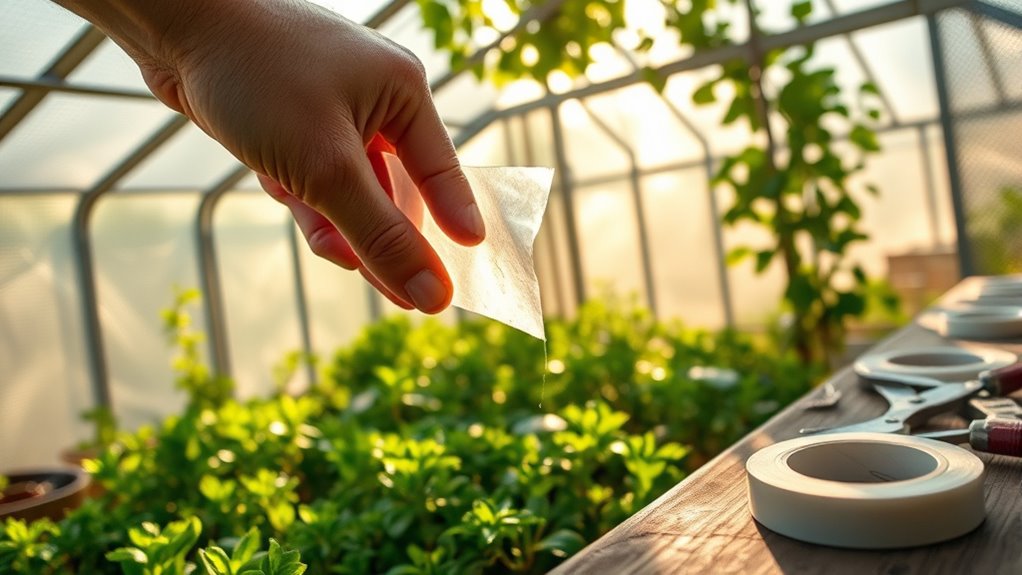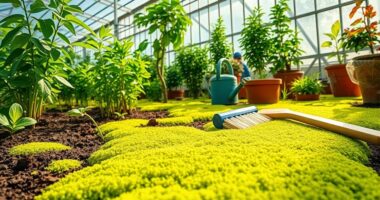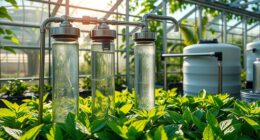To quickly fix common greenhouse wear and tear, start by sealing any cracks or broken areas with weatherproof sealants or plastic welds. Improve ventilation by opening vents or installing fans to prevent humidity buildup and pests. Check for gaps around vents or damaged panels and seal them with screen material or sealant. Regularly inspect for loose or torn screens, and repair or replace as needed. Continuing with simple maintenance will help keep your greenhouse in top shape and pest-free.
Key Takeaways
- Seal small cracks or holes with weatherproof sealants or patching tape to prevent pests and further damage.
- Use plastic welds or repair kits to temporarily fix broken panels or glass, maintaining structural integrity.
- Open vents and install additional fans to improve airflow and reduce humidity buildup quickly.
- Replace damaged or worn-out panels with durable, UV-resistant materials for long-lasting repairs.
- Regularly inspect and seal gaps around vents, doors, and panels to prevent pest entry and maintain a secure environment.

Ever wonder how to handle common greenhouse issues quickly before they worsen? The key lies in addressing problems promptly with simple fixes that can make a big difference. One of the most effective ways to keep your greenhouse running smoothly is by focusing on ventilation improvements. Proper airflow isn’t just about keeping the environment comfortable; it’s essential for preventing issues like humidity buildup, mold, and disease. If you notice condensation on the glass or plastic panels, it’s time to improve ventilation. You can do this by opening vents, installing additional fans, or adjusting existing exhaust systems. Improving airflow helps regulate temperature and humidity levels, creating a healthier environment for your plants and reducing the risk of pest problems. When pests find a cozy, humid environment, they multiply quickly, so quick ventilation fixes are necessary for pest prevention.
Improve greenhouse airflow quickly to control humidity, prevent pests, and keep your plants healthy.
If you spot pests early, take immediate action to prevent a full-blown infestation. Small holes in screens, gaps around vents, or torn plastic can serve as entry points for insects and rodents. Repairing these openings with patching tape, screen material, or sealants can stop pests from entering. Regularly inspecting your greenhouse’s structure and sealing any weak spots is a simple yet effective pest prevention strategy. Keep the area tidy by removing fallen leaves, plant debris, and weeds, which can harbor pests and attract unwanted critters. Introducing natural predators or organic pest control methods can also help keep pest populations in check without chemicals. Remember, prompt repairs and proactive pest prevention measures go hand in hand for maintaining a healthy greenhouse environment. Additionally, maintaining proper structure integrity is crucial for preventing pest entry and ensuring long-term durability.
Another quick fix involves repairing or replacing damaged panels or glass. Cracks or broken sections not only compromise the structural integrity but also create entry points for pests and pests’ breeding grounds. Use transparent sealants or specialized plastic welds to fix minor cracks temporarily, giving you more time to plan for a permanent replacement. When replacing panels, choose durable, UV-resistant materials that withstand weather and wear over time. Keeping your greenhouse sealed tight is essential, especially during seasons when pests are most active. Small repairs now save you from larger, more costly repairs later, and they greatly improve your greenhouse’s overall health and pest prevention capabilities.
Ultimately, addressing issues quickly with simple, targeted repairs helps maintain ideal growing conditions and prevents pests from gaining a foothold. Regular maintenance, combined with swift repairs like ventilation improvements and sealing gaps, ensures your greenhouse remains a productive, pest-free space. Being proactive saves you time, money, and frustration and keeps your plants thriving year-round.
Frequently Asked Questions
How Often Should I Inspect My Greenhouse for Damage?
You should inspect your greenhouse regularly to catch damage early. An ideal inspection schedule is at least once a month, especially after storms or extreme weather. Look for damage indicators like cracked glass, loose fittings, or broken seals. Regular inspections help you identify problems before they worsen, ensuring your greenhouse stays in top shape. Consistent checks also make quick fixes easier and more effective, keeping your plants protected.
What Are the Best DIY Tools for Greenhouse Repairs?
For greenhouse maintenance, you’ll want the best DIY repair kits to handle common issues. Keep a toolkit with a utility knife, waterproof sealant, duct tape, and replacement panels or plastic sheeting. These tools help you quickly patch leaks, fix broken frames, and address minor damages. Having these on hand makes DIY repairs easier, saving time and money while keeping your greenhouse in top shape.
Can Minor Repairs Extend the Lifespan of My Greenhouse?
Think of your greenhouse as a delicate garden gem; minor repairs act like a shield, helping it shine longer. By applying effective repair techniques to damaged greenhouse materials, you prevent small issues from snowballing into costly problems. Regular upkeep keeps your structure sturdy and extends its lifespan. So, yes, addressing minor repairs promptly can substantially prolong your greenhouse’s life, ensuring your plants thrive in a resilient environment.
Are There Eco-Friendly Repair Options for Greenhouses?
You can definitely find eco-friendly repair options for your greenhouse. Using sustainable materials, like recycled or biodegradable patches, helps minimize environmental impact. These patches are designed to be biodegradable, so they break down naturally over time, reducing waste. By choosing these eco-conscious solutions, you extend your greenhouse’s lifespan while supporting sustainability. It’s a smart way to repair wear and tear without harming the planet.
How Do I Protect Repaired Areas From Future Damage?
To protect repaired areas from future damage, you should apply protective coatings designed for greenhouse materials. These coatings create a barrier against UV rays, moisture, and temperature fluctuations. Additionally, use repair sealants to reinforce the repaired spots, ensuring they stay intact longer. Regular inspections and reapplication of these protective layers help maintain the integrity of your greenhouse, preventing further wear and tear and extending its lifespan effectively.
Conclusion
Now that you know these quick fixes, you can tackle greenhouse issues before they turn into bigger problems. With a little effort, you’ll keep your greenhouse in tip-top shape and avoid throwing good money after bad. Remember, a stitch in time saves nine—addressing small repairs early on can save you a lot of trouble down the road. So roll up your sleeves and get to work; your plants will thank you for it!









